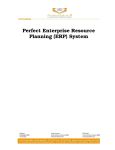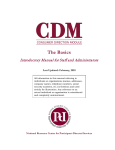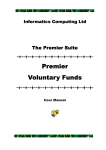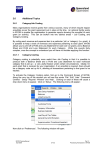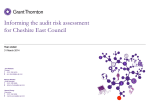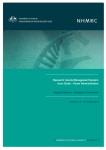Download FAR User Guide - Multicultural Aged Care
Transcript
Appendix H – FAR User Guide FINANCIAL ACCOUNTABILITY REPORT (FAR) COMMONWEALTH HACC PROGRAM USER GUIDE __________________________________________________________________________________ FAR User Guide Glossary of Terms.................................................................................................................................... 1 A Overview ......................................................................................................................................... 2 The eFAR system (in the Aged Care Provider Portal).......................................................................... 2 Submission Requirements and Deadlines........................................................................................... 3 Annual FAR Deadline....................................................................................................................... 3 Progressive FAR Deadline ............................................................................................................... 3 Adhoc FAR Deadline ........................................................................................................................ 3 Final FAR Deadline .......................................................................................................................... 3 Additional Information Requirements ................................................................................................ 4 B Structure of the FAR........................................................................................................................ 5 Part 1: Organisation Contact Information and Activity details ........................................................... 6 Part 2: Statement of Income and Expenditure ................................................................................... 7 Income ............................................................................................................................................ 8 Expenditure ................................................................................................................................... 10 Items that cannot be claimed in FARs .......................................................................................... 14 Handling of Employee Related Entitlements ................................................................................ 15 Depreciation.................................................................................................................................. 15 Part 3: Independent Audit requirement ........................................................................................... 17 Certification of Audited Statement of Income and Expenditure .................................................. 17 Segment Note Option ................................................................................................................... 17 Extraction Report Option .............................................................................................................. 17 Part 4: Statement of Compliance ...................................................................................................... 18 C FAR Alignment with Standard Chart of Accounts (SCOA) ............................................................. 19 __________________________________________________________________________________ FAR User Guide Glossary of Terms Term Description Activity The specific activity or services specified in the Schedules to each Funding Agreement Balance Sheet The statement of assets and liabilities of the Organisation. Subcontracted Services Services that are subcontracted by an Organisation to an approved subcontractor. Certification of Audited Statement of Income and Expenditure A definitive statement by an Approved Auditor, as defined in the Funding Agreement, that the Statement of Income and Expenditure is complete and accurate. Australian Government Funded Assets An asset that has been funded by the Australian Government through one-off funding, such as a one-off grant. Funding Agreement The legal agreement through which your Organisation is engaged to provide community care services on behalf of the Australian Government. Organisation The Organisation that is legally obligated to provide community care services through the Funding Agreement. Portal The Aged Care Provider Portal maintained by the Department of Health and Ageing, within which the eFAR system operates. Responsible Officer A Responsible Officer means the person occupying the position of Chief Executive Officer or Chief Financial Officer of the Organisation, or a person authorised to execute documents on behalf of the Organisation, and legally bind it. One-off Funding Funding provided to an Organisation to be used for a specific activity specified in a separate Schedule to the Funding Agreement. Statement of Compliance A certificate signed by a Responsible Officer of the Organisation, certifying that the Organisation has complied with the Funding Agreement and has used the funding provided for its intended purpose(s). Statement of Income and Expenditure A Statement of Income and Expenditure for each activity in respect of the funding provided by the Australian Government through the Funding Agreement. Trading Name The trading name of the Organisation. 1 __________________________________________________________________________________ FAR User Guide A Overview In accordance with the terms and conditions specified in your Funding Agreement/s with the Department, your Organisation is required to submit a variety of Financial Accountability Reports (FARs) each year and over the life of the activity: Annual – is required to enable the Department to acquit your Organisation’s expenses for the previous financial year; Progressive – is required to enable the Department to monitor how your Organisation is tracking during the current financial year; Adhoc – is used when the Department requires additional reporting to monitor and manage performance. Final – is required to enable the Department to acquit the activity after it has been completed. Acquittal of expenditure provides a measure of assurance and evidence that public funds have been spent for their intended purpose, in accordance with the terms and conditions under the Funding Agreement through which the funds are provided to your Organisation. The eFAR system (in the Aged Care Provider Portal) The eFAR system was introduced in 2010 for a range of community care programs and provides an electronic lodgement capability for Financial Accountability Reports. The system creates a separate FAR for each activity funded within your organisation. The eFAR has undergone minor changes and improvements and an updated version of the eFAR is now available for the Commonwealth HACC Program via the Aged Care Provider Portal (Portal). Only the Commonwealth HACC Program FARs will be available on the Portal for Progressive reports. Other community care programs (i.e. NRCP, ACHA, and DTC) will still report using the existing eFAR portal. Progressive FARs will only be generated for activities that are required to report based on the thresholds outlined in the Program Manual or in specific Program Schedules. Once your organisation has submitted the Progressive eFAR on the Portal, it will be available for assessment by the department. No hard-copy submission is required, however you will be able to print a copy for your records. The submission requirements for the Annual eFAR will be confirmed at a later date. For Annual FARs, when the assessment has been completed your organisation will be sent an acquittal outcome letter. This outcome letter will also advise of any recovery action to be taken with regards to underspent funding. For further information on the submission and completion of the eFAR using the Portal please refer to the Aged Care Provider Portal User Manual, which is available on the Department’s website. 2 __________________________________________________________________________________ FAR User Guide Submission Requirements and Deadlines All financial information provided by your organisation in the FAR for a particular financial period should relate only to that financial period. Your organisation is required to have its accounts prepared in accordance with Australian Accounting Standards Board (AASB) standards. Where specified in the Commonwealth HACC Program Manual your organisation may also be required to have your accounts audited by an approved auditor, and submit evidence of that audit as part of the Annual FAR. Note: While accounts may comply with AASB standards, there are some items that cannot be claimed as an expense in the FAR on policy grounds –please refer to the section of this guide on items that cannot be claimed in the FAR. A Responsible Officer of your Organisation is required to populate their details in the Declaration in the “Statement of Compliance” prior to submitting a Progressive FAR. A “Responsible Officer” means the person occupying the position of Chief Executive Officer or Chief Financial Officer of the Organisation, or a person authorised to execute documents on behalf of the Organisation, and legally bind it. Annual FAR Deadline You are required to submit your organisation’s Annual FAR, for a particular financial year, in accordance with the requirements specified above, to the Department by no later than 30 September in the next financial year (e.g. the 2012-13 FAR should be submitted to the Department by 30 September 2013). If for some reason there is an extension to the submission deadline, the Department will advise you in writing. If your Organisation is unable to meet this deadline, you must advise the Acquittals Helpdesk of the reasons for this prior to the deadline date by either emailing [email protected] or telephoning 02 6289 1637. Failure to meet the deadline or make alternative arrangements with the Department will result in the Department commencing compliance action, which may include the suspension of payments. Progressive FAR Deadline When required by the Program Manual and particular Program Schedules, the Progressive FAR for a particular financial year must be submitted to the Department by no later than 31 March in the applicable financial year. Adhoc FAR Deadline If an activity is required to prepare Adhoc FARs, your organisation will be advised of the frequency and deadlines for each report. Final FAR Deadline The Final FAR for an activity must be submitted within 30 business days (or as specified in your Funding Agreement) of the completion of the activity. 3 __________________________________________________________________________________ FAR User Guide Additional Information Requirements As outlined in the terms and conditions of your Funding Agreement, the Department may request additional information following receipt of the FAR. Your organisation must retain supporting documentation so that you can provide any additional information on a timely basis as necessary. If requested by the Department, your Organisation is required to provide Departmental staff with access to: any premises at which records, materials and assets related to a Funding Agreement are stored; any work which your Organisation has undertaken in delivering the activity; and reasonable access to your Organisation’s personnel regarding matters related to the activity. 4 __________________________________________________________________________________ FAR User Guide B Structure of the FAR The FAR is comprised of up to six parts. Part 1 Organisation, Contact Information and Activity Information; Part 2 Statement of Income and Expenditure; Part 3 Certification of Audited Statement of Income and Expenditure; Part 4 Statement of Compliance. Please note that not all types of FARs throughout the financial year require all parts to be completed – see table below: Type of FAR Annual Progressive Adhoc Final Part 1 – Organisational Details Yes Yes Yes Yes Part 2 – Statement of Income and Expenditure Yes Yes Yes Yes Part 3 – Certification of Audited Statement of Income and Expenditure Yes No No Yes Part 4– Statement of Compliance Yes Yes Yes Yes Parts of FAR 5 __________________________________________________________________________________ FAR User Guide Part 1: Organisation Contact Information and Activity details The details in this section relate to the Organisation which is legally contracted to provide the services through the Funding Agreement and which appears on the first page of the Funding Agreement. In the eFAR, the details will be populated based on information stored in the ‘Provider Details’ tab of the portal. If these details are incorrect, please contact your Departmental Liaison Officer. The following details are pre-populated, based on the records maintained by the Department. Name of Organisation; Australian Business Number (ABN) as per the Funding Agreement Trading name (if applicable); Name of activity; Australian Government Program (i.e. Commonwealth HACC Program) Contact Officer Details Street Address Postal Address Email Address 6 __________________________________________________________________________________ FAR User Guide Part 2: Statement of Income and Expenditure Your organisation must report on how it has used Australian Government funding for the activity in the Statement of Income and Expenditure. Only expenditure relating to the particular activity for the relevant period should be included so that the resulting net surplus (or deficit) accurately reflects the use of those funds, for their intended purpose. The income relating to the Commonwealth HACC activity for the reporting period will be prepopulated. For Progressive FARs, the income amount will be half of the annual amount, as this is a report for a six-month period. All amounts should exclude GST. They should be rounded to the nearest whole dollar i.e. do not include cents. The report is to be populated with the Income and Expenditure information relating to the delivery of services under this particular activity. When there has been a 15% over or underspend across the overall activity, a variation explanation will be required. The form in the eFAR will not allow progress/submission until this section has been completed where required. Details of information to be included in each line of the Statement of Income and Expenditure are available in the next section of this guide. 7 __________________________________________________________________________________ FAR User Guide Income Note 1 Description To be Reported Progressive/Adhoc This will be pre-populated by the Department and is based on the proportion of your annual recurrent grant made to the Organisation for the reporting period. If the amount shown is considered to be incorrect, please contact the Acquittals Help Desk. Proportion of Approved Upper Limit (AUL) Annual/Final Australian Government Funding Agreement – operational 2 Surplus funding held from previous year This will be pre-populated by the Department and is based on the payments made to the Organisation. If the amount shown is considered to be incorrect, please contact the Acquittals Help Desk on 02 6289 1637. This item only relates to Annual and Final FARs. This will be pre-populated by the Department and shows the amount of funding that was held by your organisation from the previous financial year and would have been recovered from payments in the current financial year. Please note: the amount of Australian Government Funding Agreement – operational (refer Note 1 above) plus the Surplus funding held from previous year equals the total Australian Government funding available to your organisation for the specified period. If the amount shown is considered to be incorrect, please contact the Acquittals Help Desk. 8 __________________________________________________________________________________ FAR User Guide Note Description To be Reported 3 Interest received on Government funds Any interest earned in the relevant reporting period on funds paid to the Organisation by the Department through the Funding Agreement. 4 User fees received All user fees payable from clients for the relevant reporting period. If some user fees were uncollectable and subsequently written off, these should be included, with an itemised entry in Item 17 “Other Support and Administration Costs” for debts written off. For acquittal purposes, it is assumed that any user fees received are expended before any Commonwealth funding is used. 5 Other (please specify) Other revenue generated from activities for the relevant reporting period. Note: Revenue received from other funding bodies should not be included. Your organisation’s financial systems should be able to separately identify Australian Government funds and their use, as specified in the Funding Agreement. This section is not intended to include general donations or gifts. 9 __________________________________________________________________________________ FAR User Guide Expenditure Only expenditure incurred in delivering the activity during the reporting period should be reported in the Statement of Income and Expenditure. Expenditure relevant to services operated and funded from other sources of funding should be excluded. Direct Costs ‘Direct costs’ means those costs associated with providing services to clients or providing the services specified under the Funding Agreement. They include the full cost of employees engaged in providing those services, together with direct travel and carer resources provided to clients. All other expenditure should be included in Support and Administration Costs. Note 6 Description To Be Reported Employee expenses All employee costs associated with staff engaged to provide the services to clients as detailed in the funding agreement for the activity, including: wages and salaries; superannuation; payroll tax; and other direct employee costs. Where Organisations will carry a liability into future years as a direct result of employee entitlements being accumulated during the reported financial year, the Department will allow an expense item equivalent to that liability in that financial year. The Organisation is then responsible for ensuring that adequate provisions are made to cover these and any other debts (for more detail see “Handling of Employee Related Entitlements”). Staff training should be excluded from this category and included in Support and Administration Costs. 7 Subcontracting The full cost of services, including employee costs of the subcontracted service, where this is provided through an approved subcontracting arrangement. The staff costs your Organisation incurs in relation to organising subcontracted services should be included in Item 6 “Employee expenses”. 10 __________________________________________________________________________________ FAR User Guide Note 8 Description To Be Reported Travel Travel costs incurred by employees for travel directly associated with provision of services to clients. Travel costs incurred by clients should be itemised in Item 10 “Other direct costs”. 9 Carer resources Resources provided directly to clients, e.g. wheelchairs on loan, or other similar equipment. 10 Other direct costs Any other direct costs incurred in providing services to clients, for example transport costs for clients, reimbursement of volunteer expenses and reasonable catering for volunteers should be included in this section. Costs must be itemised and a description of the expenditure provided. Support costs such as printing and postage, office supplies and property operating expenditure should be included in “other support and administrative costs” rather than in this item (see item 17). 11 __________________________________________________________________________________ FAR User Guide Support and Administration Costs ‘Support and Administration Costs’ means the cost of all administrative support provided by your Organisation to the activity. Broadly this includes all staff and costs incurred in supporting the staff providing services directly to clients. Note 11 Description To Be Reported Employee expenses All employee costs associated with staff providing support to the staff delivering services for example accounts processing staff, human resources, etc. The cost should include: wages and salaries; superannuation; payroll tax; and other employee costs Where Organisations will carry a liability into future years as a direct result of employee entitlements being accumulated during the reported financial year, the Department will allow an expense item equivalent to that liability in that financial year. The Organisation is then responsible for ensuring that adequate provisions are made to cover these and any other debts (for more detail see “Handling of Employee Related Entitlements”). 12 Training costs All staff training costs, including for those staff providing services to clients. 13 Premises and accommodation costs All costs relating to premises used for the provision of activity services. Where the activity forms part of your Organisation’s broader operations, the cost should be attributed proportionately to accurately reflect usage. 12 __________________________________________________________________________________ FAR User Guide Note Description To Be Reported 14 Depreciation Apportioned costs for the Depreciation of your Organisation’s Replaceable Assets and Other Assets with a value greater than $10,000 used in association with providing the services under the Funding Agreement. For further information please see section below on depreciation. 15 Promotion and advertising costs Costs incurred in connection with the promotion and advertising of the activity. 16 Management fees Management fees, or general overhead recovery charges, allocated to the activity by the Organisation. The attributed cost must be proportionate to the level of support actually provided to the activity. Auspice fees allocated to activity by your organisation. The attributed cost must be proportionate to the level of support actually provided to the activity. The Organisation may be asked to justify any management or auspice fees charged to the activity. 17 Other support and administration costs All support and administration costs, other than as included above. Examples of other support and administration costs include printing, stationery and postage, communications costs, accounting and professional fees and minor asset purchases below $10,000. These should be separately itemised. If user fees that were payable and subsequently written off have been included in Item 4 “User Fees received”, then the actual debt amount written off can be itemised here. This does not include Fringe Benefits Tax, donations, provision for bad debts, loans, interest paid on any loans or borrowings. 13 __________________________________________________________________________________ FAR User Guide Where staff are involved in both the provision of services to clients and also provide administrative support to the activity, their costs should be attributed to each category, based on a careful estimate of resource usage. Items that cannot be claimed in FARs The following expenditure items cannot be claimed in your organisation’s FAR i.e. they must be excluded from your Organisation’s FAR: Depreciation on land and buildings – however, your organisation can charge a rental amount in lieu of this if your organisation has not already claimed a rental charge under Premises and Accommodation costs (see Item 13). Taxes including Fringe Benefit Tax, Stamp Duty Cost of police checks for staff Provision for bad debts Expenditure that did not occur in the relevant financial year or period Profit margins Loss incurred from the disposal of an asset. 14 __________________________________________________________________________________ FAR User Guide Handling of Employee Related Entitlements Example: An organisation employs 2 staff @ $40,000 per annum. Staff can be paid up to 4 weeks sick leave full pay per annum, but on average each staff member takes 8 days sick leave per year. After 10 years continuous service, staff are entitled to 3 months long service leave, however only 20% of staff ever make it to 10 years service. If the organisation chooses to set up provision accounts in the balance sheet to meet any future costs associated with this accumulated leave, then the amount claimed would be calculated as follows: Sick leave – 8 days (actual amount taken on average) X 2 (number of staff employed) X daily rate of salary (based on $40,000 per annum). This amount would be claimed in the FAR but transferred to the balance sheet as a provision for sick leave. When staff claim sick leave, the cost of the leave is funded from the provision account and not claimed as "employee expenses”. Long Service Leave – For staff with less than 10 years service, the amount charged per annum for long service leave should be 0.3 months salary X percentage of chance they will achieve 10 years service. For staff with 10 or more years service, 0.3 months salary should be charged per annum. o If one staff member had achieved 10 years service and one had not, then the amount that could be claimed would be 0.3 X $40,000 (for the staff member with > 10 years service) plus 0.3 X 20% X $40,000 (for the staff member with <10 years service). This amount would be claimed in the FAR but transferred to the balance sheet as a provision for long service leave. Depreciation Your Organisation is able to claim depreciation on two distinct types of assets with individual item values of $10,000 or more (inclusive of GST) in your Statement of Income and Expenditure. They include: Replaceable Assets – Assets that were purchased using Australian Government funding that are one of the following types: - Motor vehicles - Office equipment - Kitchen Equipment (where required for the delivery of Service Group 4 – centrebased day care, or Service Group 6 – Meals) Other Assets - Assets that were purchased using moneys other than Australian Government funding that are used for the delivery of services for the activity. Depreciation is to be calculated on the proportion of the asset used for delivery of services under the activity. Depreciation claimed against Replaceable Assets is to be put aside for the replacement of that asset and cannot be used for any other purpose without the consent of the Department. The depreciation claimed in the ‘Replaceable Assets’ line of the Statement of Income and Expenditure must not 15 __________________________________________________________________________________ FAR User Guide exceed the amount recorded in the Replaceable Depreciation Schedule component of the Assets Register. Depreciation claimed against Other Assets is provided on the basis of depreciation in the value of assets as a result of their use in the delivery of the activity. This amount is also to be recorded in the appropriate section of the Assets Register and the amount claimed in the Statement of Income and Expenditure must not exceed the amount in the Other Depreciation Schedule component of the Assets Register. Example: An organisation is provided with $10,000 funding to purchase a proportion of a vehicle for the activity. The total vehicle price is $40,000 so the organisation uses alternative sources of funding to purchase the vehicle. This makes 25% of the vehicle a Replaceable Asset and depreciation can be claimed against this 25% to be used for replacing this asset once its usable life is complete. This component of depreciation is to be recorded in the “Depreciation – Replaceable Assets’ line of the Statement on Income and Expenditure. The vehicle is actually used for delivery of services under the activity for 50% of the time, and an additional 25% of the vehicle is considered an Other Asset. Depreciation can also be claimed against this proportion of the asset in the ‘Depreciation – Other Assets’ line of the Statement. The remaining 50% of the vehicle is not used for the delivery of services under the activity, therefore depreciation cannot be claimed on this proportion of the asset. 16 __________________________________________________________________________________ FAR User Guide Part 3: Independent Audit requirement Certification of Audited Statement of Income and Expenditure is an annual requirement for some service providers based on the requirements of their Program Schedule, and Chapter 5 of the Commonwealth HACC Program Manual. Part 3 is not required for Progressive Reports. The Department will allow the organisation to submit as part the financial accountability reporting obligation an auditor’s report based on one of the following options: Certification of Audited Statement of Income and Expenditure This certification confirms that the Statement of Income and Expenditure for the activity for the relevant reporting period is complete and accurate. Alternatively your organisation can attach a letter signed by an auditor (in lieu of Part 3) provided the letter includes certification that the Statement of Income and Expenditure for the relevant reporting period is complete and accurate. Where your organisation is not subject to audit by the Auditor General of the Australian Government or a State/Territory, the Certification of Audited Statement of Income and Expenditure must be certified by an approved auditor, in accordance with the Funding Agreement. The Auditor should also not be a principal, member, office holder or employee of the organisation. Where your organisation is subject to audit by the Auditor-General of the Australian Government or a State/Territory, your Organisation is required to provide a Certification of Audited Statement of Income and Expenditure signed by an officer responsible for auditing the administration of the funding. Please note that the Responsible Officer who signs Part 4 – Statement of Compliance cannot also sign the Certification of Audited Statement of Income and Expenditure. Segment Note Option Under this option, your organisation must incorporate any Commonwealth funding received for the National Respite for Carers Program, Commonwealth Carelink Centres and/or Dementia, Education and Training program into a community aged care services segment in your audited general purpose financial statements. The Segment Note must comply with Australian Accountability Standard (AASB) 114 Segment Reporting (as amended) and should be audited accordingly. In addition, you must complete the standard FAR requirements for other parts. Extraction Report Option Under this option, following the completion of the annual audit, service providers are to provide the independent auditor with ‘extractions’ from their financial information management system of financial information for each community care program. These extraction reports should be a comprehensive record of income and expenditure at the program (rather than activity) level, and be reconciled with the FARs. The auditor would then provide an independent Extraction Report at the community care programs level, which is certified as a reflection of the annual audit. 17 __________________________________________________________________________________ FAR User Guide Part 4: Statement of Compliance A Statement of Compliance is required for all types of FARs throughout the financial year. The Statement of Compliance must be signed by a Responsible Officer (see Section A for details) of the Organisation. The Organisation is required to complete all details in the Statement of Compliance, confirming that all funding received from the Department has been used for the provision of approved services and that all conditions included in the Funding Agreement have been met. The Statement of Compliance also requires a Responsible Officer to certify that the Assets Register has been updated and that all risk assessments relating to insurance have been carried out, and the relevant insurances been taken out. Any areas of non compliance should be fully described in detail in the section provided. Note: Your organisation must ensure that any expenditure items specifically excluded in Part 2 – Statement of Activity Income and Expenditure have not been included in your FAR. Once you have submitted your FAR using the eFAR system, your organisation should print the report using the available functionality. No hard-copy of Progressive FARs are required to be posted to the Department if they have been submitted using the eFAR in the Portal. Submission requirements of the Annual FAR will be confirmed at a later date. 18 __________________________________________________________________________________ FAR User Guide C FAR Alignment with Standard Chart of Accounts (SCOA) Income Note 1 2 3 Description To be reported Proposed SCOA Item SCOA Description Australian Government Funding Agreement operational This will be pre-populated by the Department and is based on the amount specified in the relevant schedule to the Funding Agreement. If the amount shown is considered to be incorrect, please contact the Acquittals Help Desk on (02) 6289 1637. 4-1010 – Grants This account includes operating, recurrent funds received from the Commonwealth including whole of organisation grants per capita. This includes annual funding or multi-year funding. Surplus funding held from previous year This will be pre-populated by the Department and shows the amount of funding still held by your organisation identified from previous years’ surpluses. If the amount shown is considered to be incorrect, please contact the Acquittals Help Desk on (02) 6289 1637. 4-1010 - Grants Interest earned for the relevant reporting period on funds paid to the Organisation by the Department through the Funding Agreement deposited into the prescribed bank account. 4-5010 - Interest Restricted Interest received on Government funds (Commonwealth) Operating - Recurrent This account includes (Commonwealth) operating, recurrent funds Operating - Recurrent received from the Commonwealth including This amount relates whole of organisation to and forms part of the Grant referred to grants per capita. This includes annual funding or in Note 1 above. multi-year funding. Refer to Note 1 above. 4-5020 – Interest Unrestricted This account represents bank interest earned on the investment of funds provided for a specific purpose. This account includes interested earned on cash or banked funds, classified as operating funds. 19 __________________________________________________________________________________ FAR User Guide 4 User fees received All contributions received from carers in the form of fees and donations for the relevant reporting period. 4-4010 to 4-4080 Trading/Operating Activities This includes sale of goods, fees and charges, sponsorship and licensing fees, income from raffles and gaming, sales of tickets, membership fees. 5 Other (please specify) Other revenue generated from activities for the relevant reporting period 4-2010 to 4-2050 Donations, gifts & bequests Fundraising – Gifts – made voluntarily and do not provide a material benefit to the donor. 4-3010 to 4-30540 Contributions Contributions – voluntary contributions other than donations and gifts. Note: Revenue received from other funding bodies should not be included. Organisations’ financial systems should be able to separately identify Australian Government funds and their use, as specified in the Funding Agreement. (public, government & philanthropic trusts & corporations, traders) 4-5030 to 4-5060 Other income (except interest) Income that is not in any other category e.g. sale of assets funded by the Commonwealth. 20 __________________________________________________________________________________ FAR User Guide Expenditure Direct Costs Note 6 Description To be reported Proposed SCOA Item Employee Expenses All employee costs associated with staff engaged to provide the services to clients as detailed in the Funding Agreement for the activity, including: 6-0600 to 6-0649 Wages and Salaries 6-0611 (portion of staff that are directly involved in the delivery of the activity) SCOA Description Salary and Wages: this account represents all salaries and wages paid to all staff employed by the non-profit organisation on a permanent basis or casual basis (including replacement staff). It should not include any expenses for leave taken in the current financial year by employees (e.g. Recreation Leave, Sick Leave, Long Service Leave etc) if the Organisation maintains a provision account. These costs should be funded from the organisation’s provision account. Please note that the Commonwealth recognises expenditure as an eligible item an amount equivalent to the additional liability incurred in the financial year for employee-related entitlements – see “Employee-related Entitlements” 21 __________________________________________________________________________________ FAR User Guide Note Description To be reported Proposed SCOA Item Superannuation 6-0607 Payroll Tax An account in the 6-0600 series should be set up to record payroll tax expense. Employee-related entitlements – An account in the 6-0600 series should be set up to record the amount of employeerelated entitlements. Where Organisations will carry a liability into future years as a direct result of employee entitlements being accumulated during the reported financial year, the Department will allow an expense item equivalent to that liability in that financial year. The Organisation is then responsible for ensuring that adequate provisions are made to cover these and any other debts Other direct employee costs Note: Staff training should be excluded from this category and included in Support and Administration Costs. SCOA Description This account covers all expenses relating to superannuation, as paid for salaried or casual staff. This account represents the amount equivalent to the additional liability incurred in the financial year for employee-related entitlements. This amount must be reflected in the relevant provision account in your balance sheet (Liabilities Accounts 2-1170 onwards) Any other 6-0600 series items that are not included elsewhere. 22 __________________________________________________________________________________ FAR User Guide Note Description To be reported Proposed SCOA Item SCOA Description 7 Brokerage/Subcontracting The full cost of services, including employee costs, where this is provided through an approved sub contracting arrangement. 6-0110 to 6-0200 Client Support Services these accounts cover the costs associated with services provided to client/Organisations, including brokerage. 8 Travel Travel costs incurred by employees for travel directly associated with provision of services to clients. 6-0710 This account represents all travel expenses incurred in relation to staff employed by the non-profit organisation. 9 Carer resources Resources provided directly to clients, e.g. wheelchairs on loan, or other similar equipment. 6-0210 Client Support Consumables – this account covers the costs of providing consumables, medical and surgical supplies to clients/Organisations. 10 Other direct costs Any other direct costs incurred in providing services to clients should be included in this section. Costs must be itemised and a description of the expenditure provided. Support costs such as printing and postage, office supplies and property operating expenditure should generally not be included here. Any other item in the 6-0000 series not included elsewhere 23 __________________________________________________________________________________ FAR User Guide Support and Administration Costs Note 11 Description To be reported Employee expenses All employee costs associated with staff providing support to the staff delivering services. The cost should include: Wages and Salaries Proposed SCOA Item SCOA Description 6-0611 Wages and Salaries: this account represents all salaries and wages paid to all staff employed by the non profit organisation on a permanent basis or casual basis (including replacement staff). (portion of staff that are involved in support/admin roles) It should not include any expenses for leave taken in the current financial year by employees (e.g. Recreation Leave, Sick Leave, Long Service Leave etc) if the Organisation maintains a provision account. These costs should be funded from the organisation’s provision account. Please note that the Commonwealth will fund an amount equivalent to the additional liability incurred in the financial year for employee-related entitlements – see “Employee-related Entitlements” Superannuation 6-0607 This account covers all expenses relating to superannuation, as paid for salaried or casual staff. 24 __________________________________________________________________________________ FAR User Guide Note Description To be reported Proposed SCOA Item Payroll Tax An account in the 6-0600 series should be set up to record payroll tax expense. Employee-related entitlements - Where Organisations will carry a liability into future years as a direct result of employee entitlements being accumulated during the reported financial year, the Department will allow an expense item equivalent to that liability in that financial year. The Organisation is then responsible for ensuring that adequate provisions are made to cover these and any other debts; An account in the 6-0600 series should be set up to record this amount. Other employee costs 6-0310 Employee Support & Supervision Costs SCOA Description This account represents the amount equivalent to the additional liability incurred in the financial year for employee-related entitlements. This amount must be reflected in the relevant provision account in your balance sheet (Liabilities Accounts 2-1170 onwards). This account covers all costs associated with employment support (e.g. job support, vocational development, supervision costs). It excludes salaries and wages of the staff undertaking the role. 25 __________________________________________________________________________________ FAR User Guide Note 12 Description To be reported Proposed SCOA Item SCOA Description Training costs All staff training costs, including for those staff providing services to clients. 6-0700 This account represents the cost incurred by the nonprofit organisation on staff training as well as the costs of sending staff to external conferences and training workshops. It excludes registration fees and costs of training volunteers. (Volunteer costs should be identified in “Other Support and Administration Costs”.) 13 14 Premises and accommodation costs Depreciation All costs relating to premises used for the provision of activity services. Where the activity forms part of the Organisation’s broader operations, the cost should be attributed to accurately reflect usage. 6-0100 – Cleaning 6-0650 - Security Expenses This account represents the costs of security paid for the current year including alarm systems, replacement locks, keys and security firms and an outgoings component. Depreciation on assets ($>10,000) that are considered Other Assets or Replaceable Assets that are used in association with providing the services under the Funding Agreement. 6-0260 Depreciation – Motor Vehicle For the proportion of motor vehicles that is used for the activity. 6-0270 Depreciation – Plant & Equipments For the proportion of plant & equipment that is used for the activity. Depreciation on buildings is not allowed. 6-0570 - Rent 26 __________________________________________________________________________________ FAR User Guide 15 Promotion and advertising costs Costs incurred in connection with the promotion and advertising of the activity. 6-0020 This account covers all advertising, marketing and promotional fees paid by your organisation in the course of marketing, advertising and promoting the activity. It includes all printing relating to promotional material and website maintenance, design and content. 16 Management and auspice fees All management fees, or general overhead recovery charges, allocated to the activity by the Organisation. 6-0470 Management Fees This account represents fees paid to another organisation which performs governance and financial services for your organisation (e.g. payroll services, shared office space fees etc) 6-0060 - Auspice Fees This account represents fees paid by a non-profit organisation to another organisation for providing support. The auspice organisation signs agreements, carries financial risk and legal responsibility for activities of the auspice organisation. 6-0010 Accounting Fees This account represents accounting and book keeping fees. The Organisation may be asked to justify any management fees charged to the activity. 17 Other support and administration costs All support and administration costs, other than as included above. Examples of other support and administration costs include printing, stationery and postage, communications costs, accounting and 27 __________________________________________________________________________________ FAR User Guide professional fees and minor asset purchases below $10,000, volunteer costs. This does not include Fringe Benefits Tax, donations, bad debts, loans, loss incurred from the disposal of an asset etc. Please contact the Acquittals Helpdesk for more information. 6-0050 - Audit Fees 6-00780 - Bank Charges 6-0730 Volunteer Costs Any other item in the 6-0000 series not included elsewhere This account represents fees directly associated with an audit of financial statements. This account represents all charges associated with the various bank accounts held by a non-profit organisation in relation to the funded activity. This account represents all costs relating to volunteers, including training of volunteers. 28 __________________________________________________________________________________ FAR User Guide






























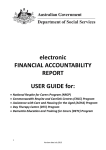
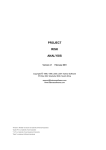
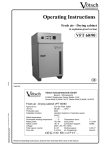
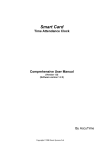
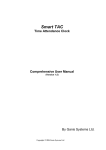
![[WAP035] [Evaluating Twittervane] Project Final Report](http://vs1.manualzilla.com/store/data/005882807_1-a2020170b6b6795bf72e9c3d683c54a5-150x150.png)

